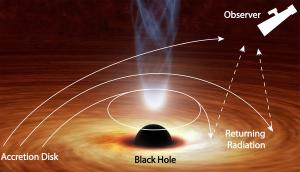Blog
Double Tap
14 April 2020
 NASA/JPL-Caltech/R. Hurt (IPAC)/R. Connors (Caltech)
NASA/JPL-Caltech/R. Hurt (IPAC)/R. Connors (Caltech)Black holes are often described in terms of their event horizons. This is the distance at which light becomes forever trapped. But even when light doesn’t cross the event horizon, its behavior can become quite strange. The rotation of a black hole can twist a beam of light into curves, and light can even be trapped in orbit around a black hole. When light is near a black hole, computing its path can be difficult.
As our simulations and observations have gotten more sophisticated, we’ve learned some interesting things. One of these is how material near a black hole can get so superheated. Many black holes have a disk of material closely orbiting them known as an accretion disk. These often emit powerful x-rays. By observing these bright disks we can understand how black holes grow and evolve.
Recently a team observed one particular x-ray region near a black hole, and found it rather odd.1 When they studied the spectrum of x-rays, they found it included both emission and reflection effects. Most of the light was being emitted from the hot gas of the accretion disk, but some of the light was caused by x-rays reflecting off the disk. Since the accretion disk is the only thing in the region emitting x-rays, the scattered light must come from the disk as well.
It is the first evidence of strongly gravitated light reheating an accretion disk. What happens is that light emitted from the inner region of the disk is deflected by the black hole so that it bends back to another region of the disk. This has been predicted by black hole models for a while, but this is the first direct observation of the effect.
The team hopes to use these kinds of observations to learn about the mass and rotation of black holes. Since rotating black holes twist light as well as bend it, studying the reflected light could allow us to measure the rate of rotation. It’s an interesting technique that could help us better understand these odd objects of gravity.
Connors, Riley MT, et al. “Evidence for Returning Disk Radiation in the Black Hole X-Ray Binary XTE J1550–564.” The Astrophysical Journal 892.1 (2020): 47. ↩︎